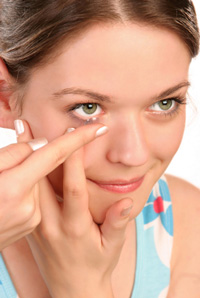Contact Lenses

Contact lenses, when used properly, are very convenient, and with the latest advancements in technology, they are extremely comfortable. Most of the time, you will hardly know you are wearing them, though you will certainly notice how clear and accurate your vision is. Contact lenses are small lenses worn on the surface of the eye, or cornea, to correct vision. Lenses are sometimes worn for cosmetic purposes only. We recommend wearing contact lenses in conjunction with eye glasses. This allows you to best meet your overall lifestyle needs while protecting the integrity of your overall eye health.
We will discuss the option that is best for you. Many patients choose contact lenses for their primary vision correction and glasses as a backup option. Many patients who wear glasses have activities and events where they would rather not wear their glasses and they choose contact lenses for these times.
Contact Lens Types
The types of contact lenses available have exploded in the past few years. There are contact lenses available for almost everyone. Many of our patients were told in the past that they could not wear contacts, or they tried unsuccessfully to wear contact lenses. You owe it to yourself to see what is new. We carry many options, and promise to do our best in selecting contact lenses that you will love wearing. The following list is a brief look at some of the options available.
Conventional Soft Lenses
Soft lenses are very comfortable and come in a variety of types, depending on the wearer’s needs. Conventional soft lenses are worn during the day, and cleaned and stored at night. Usually once a week the lenses must be cleaned using an enzymatic cleaner, which removes protein deposits. These lenses may last for a year or more if your prescription stays the same and you take good care of them. Because of newer technology, these lenses are now not often recommended.

Frequent Replacement Soft Lenses
These lenses are similar to conventional soft lenses except they are replaced more frequently. Oftentimes, they are worn for one-month periods and then replaced. Other frequent replacement soft lens types are worn two to three months before they are replaced. Like conventional soft lenses, they have to be cleaned and stored at night.

Disposable Soft Lenses
Disposable soft lenses are much more popular than conventional soft lenses. These lenses are worn for a period of time and then, of course, thrown away. The most well-known disposables last for two weeks. There are also one-day disposables. These are perfect for many patients who were told they could not wear contact lenses because of allergies or mild dry eye conditions. They have a low cost per lens and are also popular for athletes and hobbyists who do not necessarily want to wear contact lenses every day.

Soft Colored Contact Lenses
Next, you have tinted soft lenses, available in conventional, disposable, or frequent replacement types. With tinted soft lenses, you can change or enhance your eye color. Even if you do not need corrective lenses, you can use “plano” colored contacts to change your eye color. It is important to be fitted by an eye doctor for colored contact lenses even if you do not need a prescription; wearing the wrong style can damage your cornea.

Bifocal Soft Lenses
Recent technology has greatly improved bifocal soft lenses. Many patients past their 40s who need bifocals can now enjoy the comfort and benefits of soft contact lenses. Monovision, with one lens for distance and one for near, is another common solution for those needing a separate distance and near prescription.

Toric Soft Lenses
Toric lenses are used to correct astigmatism. Astigmatism is a vision condition where an irregularly shaped cornea affects the vision. In the past, the only options for those with astigmatism were either glasses or hard gas permeable contact lenses. But toric lenses, which are lenses with a special shape, now offer an alternative. There are several types of toric lenses to choose from.

Extended Wear Soft Lenses
Extended wear lenses, the result of new technology in lens materials, transmit more oxygen to the cornea of the eye. Some of these lens materials are FDA approved to be worn up to 30 days, day and night, without removal. Extended wear lenses can last one week, two weeks, or one month, depending upon the lens material and your doctor’s recommendations.

Rigid Gas Permeable (RGP) Lenses
As the name implies, these lenses are hard and gas permeable. If you’ve been told you cannot wear soft lenses, RGP lenses are often a great alternative. RGP lenses are available in specialized designs to correct just about any vision disorder.

Solutions
There are a variety of solutions available from many different manufacturers. The important thing to remember is that not every solution is right for every type of contact lens. Some contact lenses require the use of multipurpose solutions, while others require separate solutions for the four steps in contact lens care: disinfecting, cleaning, rinsing, and enzyming. Use only the lens solutions that are recommended by the eye doctor. If you wish to change brands, check with our office first. Many generic brand solutions can cause corneal damage when used with certain lens materials

